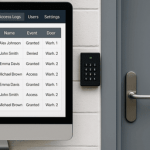
In the manufacturing industry, security isn’t just about protecting assets—it's about ensuring the safety of workers, safeguarding intellectual property, and maintaining operational efficiency. With evolving threats, increased regulatory requirements, and growing facilities, implementing a robust access control system has become a necessity for manufacturers. Here's why access control is crucial for the manufacturing industry and how it can transform security and productivity.
Why the Manufacturing Industry Needs Access Control Systems
- Protection of Assets
Manufacturing facilities house expensive equipment, raw materials, and finished goods. Without proper access controls, these assets are vulnerable to theft, vandalism, or misuse. An access control system ensures that only authorized personnel can enter certain areas, reducing the risk of theft or damage. - Workplace Safety
Manufacturing environments often involve hazardous equipment and restricted zones where safety protocols must be strictly followed. Access control systems can limit entry to these high-risk areas, preventing accidents and ensuring compliance with workplace safety standards. - Intellectual Property Security
In today’s competitive market, manufacturers often deal with sensitive intellectual property, including proprietary designs, formulas, or processes. Access control systems can secure areas housing intellectual property, ensuring only trusted personnel have access. - Operational Efficiency
Access control systems do more than enhance security—they improve workflow. With systems that integrate seamlessly with time and attendance software, manufacturers can track employee movement, ensuring efficient shift transitions and optimizing workforce deployment. - Compliance with Regulations
Manufacturers are often subject to industry-specific regulations requiring detailed records of who enters and exits their facilities. An access control system provides an automated and reliable way to maintain these records, ensuring compliance with standards such as ISO certifications or OSHA regulations.
Key Features of Access Control Systems for Manufacturing
- Multi-Level Access
Manufacturing facilities often require a tiered access system:- General employees can access production areas.
- Supervisors can access sensitive equipment zones.
- Executives can enter offices with financial or strategic information.
Access control systems allow administrators to easily assign and manage these access levels, ensuring the right people are in the right places.
- Integration with Video Surveillance
Integrating access control with video surveillance creates a comprehensive security solution. If unauthorized access is attempted, the system can trigger cameras to record the incident, providing visual documentation. - Biometric and Key Card Access
- Biometrics: Fingerprint or facial recognition adds an extra layer of security.
- Key Cards/FOBs: Easy to distribute, track, and deactivate if lost.
- Real-Time Monitoring and Alerts
Modern access control systems provide real-time monitoring and alerts. Facility managers can immediately respond to breaches or suspicious activity, reducing downtime and preventing potential threats. - Cloud-Based Management
Cloud-based access control systems allow remote management of security. Facility managers can update access permissions, monitor entry logs, and respond to alerts from anywhere, improving flexibility and control.
Emerging Trends in Access Control for Manufacturing
- AI-Powered Access Control
Artificial intelligence is revolutionizing access control by predicting and mitigating security risks. AI-driven systems analyze patterns of movement, identify anomalies, and alert facility managers in real-time. - Mobile Access Credentials
Employees can now use smartphones or smartwatches to gain access to restricted areas, reducing costs associated with lost or stolen cards. - Cloud-Based Access Control
These systems allow for remote management and real-time monitoring, making them ideal for multi-location manufacturing companies. - Biometric Authentication
Fingerprint and facial recognition ensure that only authorized personnel can access sensitive areas, providing an extra layer of protection. - Integration with IoT and Smart Devices
IoT integrations improve energy efficiency by automatically adjusting systems like lighting or HVAC based on room occupancy. - Predictive Maintenance for Security Systems
AI and IoT-driven predictive maintenance ensure that access control systems remain operational by addressing potential failures before they occur.
Benefits of Access Control Systems for Manufacturing
- Enhanced Security
Minimize risks of theft, sabotage, or unauthorized entry by restricting access to critical areas. - Increased Accountability
Detailed logs of employee movements foster responsibility and simplify incident investigations. - Simplified Management
Eliminate the logistical nightmare of managing physical keys with seamless digital systems. - Cost Efficiency
Reduce long-term costs associated with theft, vandalism, and downtime. - Scalability
Modern access control systems can scale with facility growth, simplifying future upgrades or expansions.
Conclusion: Why Manufacturers Can't Ignore Access Control
Access control systems are no longer optional in the manufacturing industry. They provide the security, efficiency, and accountability needed to thrive in a competitive market. By protecting assets, ensuring workplace safety, and simplifying management, access control systems enable manufacturers to focus on what they do best—producing high-quality goods.
If you’re in the manufacturing industry and want to explore how access control systems can revolutionize your facility, contact SSP today. Let us help you design a customized solution that meets your unique needs.


